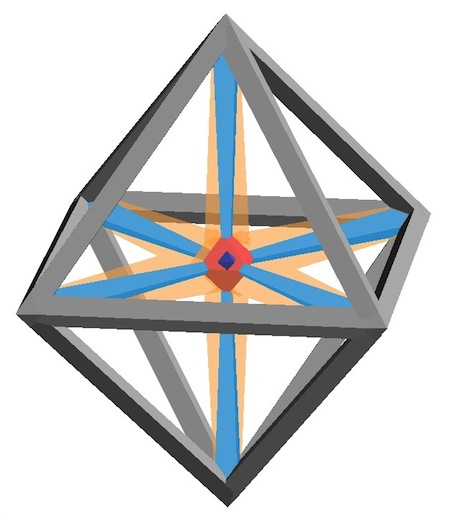“Trey, I have something for you.”
Trey hears a voice, but he doesn’t see anybody. “Ah, Tera, how lovely to, um, hear you.”
“Thanks. I hope you still feel as positive when you see my picture of the four dimensional diamond shape.”
“Why, is there something wrong with it?”
“No, to me it looks like a perfectly lovely and symmetric shape. But your mileage may vary.”
Just then a shape materializes in the air front of him. But it’s not like any shape he’s ever seen before. “Are you sure that’s the four dimensional version of an octahedron?” Trey asks doubtfully.
“Well, yes, if we follow Ariel’s rules for how to draw these things. As you can see, I’m using little octagons for the corners.”

“I see a big octagon with some crosses inside it,” Trey says.
“Actually, nothing is inside. The big red corner is ‘near’ and the little dark blue corner is ‘far’. The edges that come ‘near’ to meet the red corner are orange, and the edges that go ‘far’ to meet the blue corner are teal.
“And what about all the stuff that’s gray?”
“Oh, those are the parts that lie inside your three dimensional space — neither near nor far.”
“So the fact that the red corner and the blue corner look like they’re in the same place…”
“…is an illusion,” she said, finishing his thought. “They look like they’re in the same place because our extra dimension is only seen edge-on in your world. Actually those two corners are as distant from each other as the distance from the bottom to the top of the whole shape.”
“Oh, I see now,” Trey says, “there are eight corners all together — the six in my world, plus near and far.”
“You’ve got it! And all eight corners are on the outside. How many edges do you see?”
Trey is starting to feel more confident. “Let me see … twelve grey edges, plus six orange edges, plus six teal edges … twenty four. Is that right?”
“Yes, that’s perfect! Any other questions?”
“Just one. A square or diamond has area inside. A cube or octahedron has volume inside. So what’s inside one of these?”
“Oh dear,” Tera says, “that’s a harder question.”




